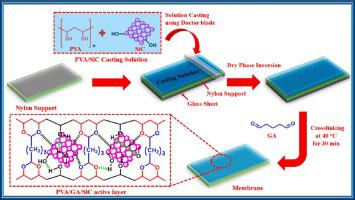当前位置:
X-MOL 学术
›
Results Chem.
›
论文详情
Our official English website, www.x-mol.net, welcomes your feedback! (Note: you will need to create a separate account there.)
Enhancing the efficiency of polymeric-inorganic composite mixed matrix membrane for oil/water separation via SiC decoration in the polyvinyl alcohol/glutaraldehyde framework
Results in Chemistry Pub Date : 2024-04-04 , DOI: 10.1016/j.rechem.2024.101483 Mohammad Alqassab , Abdul waheed , Umair Baig , Shadi W. Hasan , Isam H. Aljundi
Results in Chemistry Pub Date : 2024-04-04 , DOI: 10.1016/j.rechem.2024.101483 Mohammad Alqassab , Abdul waheed , Umair Baig , Shadi W. Hasan , Isam H. Aljundi

|
Oily wastewater presents a significant challenge that requires attention from the scientific community to not only treat it but also transform it into a valuable resource. Membrane-based separation techniques offer several advantages for treating oily wastewater, particularly in terms of ease of operation and lower energy requirements. The present research was aimed to develop polymeric-inorganic composite mixed matrix membranes (MMMs) for the treatment of surfactant stabilized oil-in-water (O/W) emulsions. These composite MMMs were fabricated using a non-solvent induced phase separation (NIPS) method, with polyvinyl alcohol (PVA)/glutaraldehyde (GA) serving as the matrix polymer and silicon carbide (SiC) nanoparticles incorporated into the matrix on a Nylon support. The concentrations of PVA (4, 10, and 12 wt%) and SiC nanoparticles (0, 0.1, 0.5, 1, 5, and 10 wt% relative to PVA) were varied for fabricating MMMs. In addition, other factors such as crosslinking times (10, 30, 60, and 240 min), and method of phase inversion (dry and wet) were also studied to yield the best-performing MMMs for O/W separation. The SiC content in the MMMs was found to have a significant impact on the physical characteristics of the membranes, such as surface morphology and porosity, which ultimately influenced the membrane performance. Hence, out of the six membranes tested for O/W separation, the M0.5 membrane containing 0.5 wt% SiC demonstrated high rejection (85 %) of total organic carbon (TOC) and a flux of 569.3 LMH when utilizing 100 ppm diesel O/W emulsion as the feed at 4 bar. This study underscores the potential of SiC MMMs for water treatment applications, while also emphasizing the need for further research to optimize their performance and resistance to fouling.
中文翻译:

通过聚乙烯醇/戊二醛骨架中的 SiC 修饰提高聚合物-无机复合混合基质膜的油/水分离效率
含油废水是一项重大挑战,需要科学界的关注,不仅要对其进行处理,还要将其转化为宝贵的资源。基于膜的分离技术为处理含油废水提供了多种优势,特别是在易于操作和较低的能源需求方面。本研究旨在开发用于处理表面活性剂稳定的水包油(O/W)乳液的聚合物-无机复合混合基质膜(MMM)。这些复合MMM是使用非溶剂诱导相分离(NIPS)方法制造的,以聚乙烯醇(PVA)/戊二醛(GA)作为基质聚合物,并将碳化硅(SiC)纳米颗粒纳入尼龙载体上的基质中。为了制造 MMM,PVA(4、10 和 12 wt%)和 SiC 纳米粒子(相对于 PVA 为 0、0.1、0.5、1、5 和 10 wt%)的浓度各不相同。此外,还研究了其他因素,如交联时间(10、30、60 和 240 分钟)和相转化方法(干法和湿法),以产生用于 O/W 分离的最佳性能 MMM。研究发现 MMM 中的 SiC 含量对膜的物理特性(例如表面形态和孔隙率)有显着影响,最终影响膜的性能。因此,在用于 O/W 分离测试的六种膜中,含有 0.5 wt% SiC 的 M0.5 膜在使用 100 ppm 柴油 O 时表现出对总有机碳 (TOC) 的高截留率 (85%) 和 569.3 LMH 的通量/W乳液作为4巴下的进料。这项研究强调了 SiC MMM 在水处理应用中的潜力,同时也强调需要进一步研究以优化其性能和抗污性。
更新日期:2024-04-04
中文翻译:

通过聚乙烯醇/戊二醛骨架中的 SiC 修饰提高聚合物-无机复合混合基质膜的油/水分离效率
含油废水是一项重大挑战,需要科学界的关注,不仅要对其进行处理,还要将其转化为宝贵的资源。基于膜的分离技术为处理含油废水提供了多种优势,特别是在易于操作和较低的能源需求方面。本研究旨在开发用于处理表面活性剂稳定的水包油(O/W)乳液的聚合物-无机复合混合基质膜(MMM)。这些复合MMM是使用非溶剂诱导相分离(NIPS)方法制造的,以聚乙烯醇(PVA)/戊二醛(GA)作为基质聚合物,并将碳化硅(SiC)纳米颗粒纳入尼龙载体上的基质中。为了制造 MMM,PVA(4、10 和 12 wt%)和 SiC 纳米粒子(相对于 PVA 为 0、0.1、0.5、1、5 和 10 wt%)的浓度各不相同。此外,还研究了其他因素,如交联时间(10、30、60 和 240 分钟)和相转化方法(干法和湿法),以产生用于 O/W 分离的最佳性能 MMM。研究发现 MMM 中的 SiC 含量对膜的物理特性(例如表面形态和孔隙率)有显着影响,最终影响膜的性能。因此,在用于 O/W 分离测试的六种膜中,含有 0.5 wt% SiC 的 M0.5 膜在使用 100 ppm 柴油 O 时表现出对总有机碳 (TOC) 的高截留率 (85%) 和 569.3 LMH 的通量/W乳液作为4巴下的进料。这项研究强调了 SiC MMM 在水处理应用中的潜力,同时也强调需要进一步研究以优化其性能和抗污性。



























 京公网安备 11010802027423号
京公网安备 11010802027423号